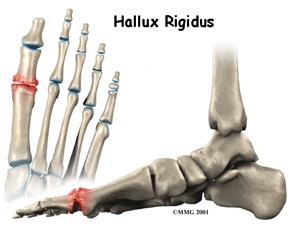GREAT TOE ARTHRITIS (HALLUX RIGIDUS)
Arthritis may involve the joint where the great toe meets the foot. This joint is called the metatarsophalangeal (MTP) joint. In the MTP joint, as in any joint, the ends of the bones are covered by a smooth articular cartilage. If wear-and-tear or injury damage the articular cartilage, the raw bone ends can rub together. A bone spur, or overgrowth, may develop on the top of the bone. This overgrowth can prevent the toe from bending as much as it needs to when you walk. The result is a stiff big toe, or hallux rigidus.
 Hallux rigidus usually develops in adults between the ages of 30 and 60 years. No one knows why it appears in some people and not others. It may result from an injury to the toe that damages the articular cartilage or from differences in foot anatomy that increase stress on the joint.
Hallux rigidus usually develops in adults between the ages of 30 and 60 years. No one knows why it appears in some people and not others. It may result from an injury to the toe that damages the articular cartilage or from differences in foot anatomy that increase stress on the joint.
TREATMENT OPTIONS
Nonsurgical Treatment:
1) Nonsteroidal anti-inflammatory drugs (NSAIDs). NSAIDs, such as ketoprofen, ibuprofen (Advil, Motrin, others) and naproxen (Aleve), may ease pain and inflammation.
2) Shoe modifications - Wearing a shoe with a large toe box will reduce the pressure on the toe, and you will probably have to give up wearing high heels. Your doctor may recommend that you get a stiff-soled shoe with a rocker or roller bottom design and possibly even a steel shank or metal brace in the sole. This type of shoe supports the foot when you walk and reduces the amount of bend in the big toe.
3) Corticosteroids – and injection with a steroid/cortisone to the joint may also help reduce pain and inflammation. However, not all patients get full relief from this and the injection can be quite painful.
Surgical Treatment:
There are many different types of surgery for this problem and depends on the severity of the arthritis.
1) Cheilectomy - This surgery is usually recommended when damage is mild or moderate. It involves removing the bone spurs as well as a portion of the foot bone, so the toe has more room to bend. The incision is made on the top of the foot. The toe and the operative site may remain swollen for several months after the operation, and you will have to wear a wooden-soled sandal for at least two weeks after the surgery. But most patients do experience long-term relief.
2) Arthrodesis - Fusing the bones together (arthrodesis) is often recommended when the damage to the cartilage is severe. The damaged cartilage is removed and pins, screws, or a plate are used to fix the joint in a permanent position. Gradually, the bones grow together. This type of surgery means that you will not be able to bend the toe at all. However, it is the most reliable way to reduce pain in these severe cases.
For the first six weeks after surgery, you will have to wear a cast and then use crutches for about another six weeks. You won't be able to wear high heels, and you may need to wear a shoe with a rocker-type sole.
3) Arthroplasty (joint replacment) - The gold standard for treatment is arthrodesis of the great toe. However, recent new “total toe” implants have increased the popularity of joint replacement among surgeon. The joint surfaces are removed and an artificial joint is implanted. This procedure may relieve pain and preserve joint motion. However, it is unclear how long these joint replacement last.
To find out more information on Great Toe Arthritis, please visit the Orthopaedic connection website of American Academy of Orthopaedic Surgeons.



 Hallux rigidus usually develops in adults between the ages of 30 and 60 years. No one knows why it appears in some people and not others. It may result from an injury to the toe that damages the articular cartilage or from differences in foot anatomy that increase stress on the joint.
Hallux rigidus usually develops in adults between the ages of 30 and 60 years. No one knows why it appears in some people and not others. It may result from an injury to the toe that damages the articular cartilage or from differences in foot anatomy that increase stress on the joint.